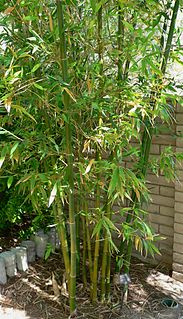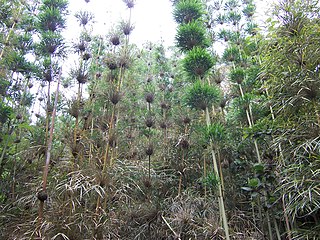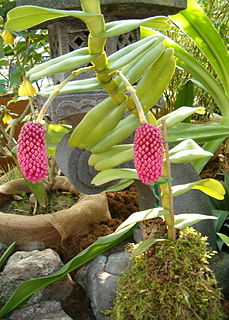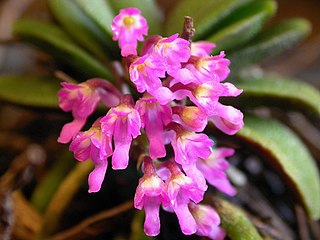
Bambusa is a large genus of clumping bamboos. Most species of Bambusa are rather large, with numerous branches emerging from the nodes, and one or two much larger than the rest. The branches can be as long as 11 m (35 ft).

Grevillea is a diverse genus of about 360 species of evergreen flowering plants in the family Proteaceae, native to rainforest and more open habitats in Australia, New Guinea, New Caledonia, Sulawesi and other Indonesian islands east of the Wallace Line. It was named in honour of Charles Francis Greville, an 18th century patron of botany and co-founder of the Royal Horticultural Society. The species range from prostrate shrubs less than 50 cm (20 in) tall to trees 35 m (115 ft) tall. Common names include grevillea, spider flower, silky oak and toothbrush plant. Closely related to the genus Hakea, the genus gives its name to the subfamily Grevilleoideae.

Nastus is a genus of slender, erect, scrambling or climbing bamboos in the grass family. It is native to Southeast Asia, Papuasia, and certain islands in the Indian Ocean.

Patersonia is a genus of flowering plants in the family Iridaceae commonly known as native iris or native flag. It was first described as a genus in 1807 by Robert Brown. It is native to Australia, New Guinea, New Caledonia, and insular Southeast Asia. The genus name is a tribute to the first Lieutenant Governor of New South Wales in Australia, William Paterson.

Banksia nobilis, commonly known as the golden dryandra, great dryandra or kerosene bush, is a shrub of the family Proteaceae which is endemic to Western Australia. It occurs on lateritic rises from Eneabba to Katanning in the state's Southwest Botanic Province. With large pinnatifid leaves with triangular lobes, and a golden or reddish pink inflorescence, it is a popular garden plant. It was known as Dryandra nobilis until 2007, when all Dryandra species were transferred to Banksia by Austin Mast and Kevin Thiele. There are two subspecies, B. nobilis subsp. nobilis and B. nobilis subsp. fragrans.
Banksia proteoides, commonly known as king dryandra, is a shrub endemic to Western Australia. It was known as Dryandra proteoides until 2007, when all Dryandra species were transferred to Banksia by Austin Mast and Kevin Thiele.

Lambertia multiflora, commonly known as many-flowered honeysuckle, is a multi-stemmed shrub which is endemic to the south-west of Western Australia. It grows to between 0.5 and 2.5 metres high and flowers from winter to summer.

Liparis, commonly known as widelip orchids, sphinx orchids or 羊耳蒜属 is a cosmopolitan genus of more than 350 species of orchids in the family Orchidaceae. Plants in this genus are terrestrial, lithophytic or epiphytic herbs with a wide range of forms. The flowers are usually resupinate and small to medium sized, yellow, yellow-green or purplish with spreading sepals and petals. The labellum is usually larger than the sepals and petals and is lobed, sometimes with a toothed or wavy margin and one or two calli at its base.

Thysanotus is a genus of perennial herbs in the family Asparagaceae, subfamily Lomandroideae. They are mostly native to Australia with 45 of the 50 known species occurring in Western Australia alone, although a few species range northward into New Guinea and Southeast Asia as far north as southern China.

Tropidia, commonly known as crown orchids or as 竹茎兰属 , is a genus of about thirty species of evergreen terrestrial orchids in the family Orchidaceae. They have thin, wiry stems with two or more tough, pleated leaves with a flowering spike at the top of the stem, bearing crowded flowers. Species in this genus are distributed across the warmer parts of both the Eastern and Western Hemispheres.

Robiquetia, commonly known as pouched orchids, or 寄树兰属 , is a genus of flowering plants from the orchid family, Orchidaceae. Plants in this genus are epiphytes with long, sometimes branched, fibrous stems, leathery leaves in two ranks and large numbers of small, densely crowded flowers on a pendulous flowering stem. There are about eighty species found from tropical and subtropical Asia to the Western Pacific.

Caesia is a genus of herbs in the family Asphodelaceae, subfamily Hemerocallidoideae, native to Australia, New Guinea, Madagascar and Southern Africa. The mostly 3-lobed seed capsules contain rounded black seeds. The genus was named in honour of Federico Cesi (1585-1630), an Italian scientist.
- Caesia alpina Hook.f. - alpine grass-lily - New South Wales, Tasmania, Victoria
- Caesia calliantha R.J.F.Hend. - blue grass-lily - New South Wales, Tasmania, Victoria, South Australia
- Caesia capensis(Bolus) Oberm. - Cape Province of South Africa
- Caesia chlorantha F.Muell. - New South Wales, Queensland, Western Australia
- Caesia micrantha Lindl. - New South Wales, Tasmania, Victoria, South Australia, Western Australia, Queensland
- Caesia occidentalis R.Br. - Western Australia
- Caesia parviflora R.Br. - pale grass-lily - Queensland, New South Wales, Tasmania, Victoria, South Australia, Western Australia
- †Caesia rigidifolia F.Muell. - Queen Victoria Springs in Western Australia but extinct. Last recorded near Zanthus in 1875.
- Caesia sabulosaBoatwr. & J.C.Manning - Cape Province
- Caesia setifera Baker - Queensland, Western Australia, Northern Territory, New Guinea
- Caesia subulataBaker - Madagascar
- Caesia viscida Keighery - Western Australia

Velleia is a genus of herbs in the family Goodeniaceae. Of the 22 species, 21 are endemic to Australia, and one is endemic to New Guinea. The genus was named by James Edward Smith, after Thomas Velley.

Pholidota, commonly known as rattlesnake orchids, is a genus of flowering plants from the orchid family, Orchidaceae. Plants in this genus are clump-forming epiphytes or lithophytes with pseudobulbs, each with a single large leaf and a large number of small, whitish flowers arranged in two ranks along a thin, wiry flowering stem that emerges from the top of the pseudobulb. There are about thirty five species native to areas from tropical and subtropical Asia to the southwestern Pacific.

Micropera, commonly known as dismal orchids or 小囊兰属 is a genus of about twenty species of flowering plants from the orchid family, Orchidaceae. Plants in this genus are large epiphytes with thick roots, long, fibrous stems, linear leaves and whitish or yellow, non-resupinate flowers. The sepals and petals are similar to each other and the labellum is shoe-shaped or sac-like and has three lobes. It is found from Tibet to tropical Asia and the western Pacific Ocean.

Peristylus, sometimes commonly known as ogre orchids or bog orchids is a genus of flowering plants from the orchid family, Orchidaceae. It consists of over 100 known species found across much of eastern and southern Asia as well as in Australia and on many islands of the Indian and Pacific Oceans.

Schoenorchis, commonly known as flea orchids, or 匙唇兰属 , is a genus of flowering plants from the orchid family, Orchidaceae. Plants in this genus are small epiphytes with thin roots, thin leafy stems with leaves in two ranks and tiny fragrant, almost tube-shaped flowers with a prominently spurred labellum. There are about twenty five species found from tropical and subtropical Asia to the Western Pacific.

Adenanthos barbiger, the hairy jugflower or hairy glandflower, is a species of shrub in the family Proteaceae. It is endemic to the south-west of Western Australia. It usually grows to 1 metre high, and has bright red flowers that appear mostly between August and December. The species was first formally described in 1839 by English botanist John Lindley in A sketch of the vegetation of the Swan River colony.

Haemodorum is a genus of herbs in the family Haemodoraceae, first described as a genus in 1798 by James Edward Smiith. The genus is native to New Guinea and Australia. The type species is Haemodorum corymbosum Vahl, first described by Martin Vahl in 1805.
Neololeba atra, the black bamboo, is a species of tropical Asian, Australian, and Papuasian genus of bamboos in the grass family.

















